Immigration of Labour: A Case Study of Bangladesh
Info: 7611 words (30 pages) Dissertation
Published: 10th Dec 2019
Tagged: International StudiesImmigration
Table of Contents
1.1 Migrants, Immigrants and Emigrants
1.2.4 Immigration of Bangladesh
3.0 Bangladesh migrants to Malaysia
3.1 Trend Analysis of Bangladesh migrant to Malaysia
3.2 The reason that made Bangladeshi migrating
3.3 Types of the occupation/jobs
3.4 Profile of people that migrant
3.5 Contribution of the migration labour from Bangladesh to Malaysia
1.0 Introduction
1.1 Migrants, Immigrants and Emigrants
As the world moving and changing fast, so the migration is becoming to one of the important factors to be considered. According to the oxford dictionary, the definitions of migrant is simply means that people are process of relocating to or has already moved to another country that intend to find work and better living conditions but they were not born in that country, migrant is the broadest term that may differ among variety of data sources and law, in some policies, the people that born in the country can be defined as a migrant (Anderson, 2017). Under the term of migrant there are immigrant and emigrant, immigration refer to that person that live and work temporarily or permanently in new country, region or environment which means that may help in the development of diversities in culture, societies in that place (Parry, 2017). Emigrants is can be defines as a person who leave their region or country to settle down in another country (Diffencom, 2017).
1.2 About Bangladesh
1.2.1 Geographical
Bangladesh is a small country in Southern Asia which is gained the independence from Pakistan in 1971 with population about 158.5 million people, and 98% of people are Bengalis and the other 2% is from Burmese border and Bihari immigrants by the border between the India and Myanmar, the capital city is called Dhaka (Szczepanski, 2017). Bangladesh is located in Southern Asia which is called the land of Bengals, because it is bordering the Bay of Bengal between India and Myanmar (Burma) and the southern part of country opens into the Bay of Bengal (Sajid, Russell, 2017). Bangladesh has the 148,460 sq. km for total area, which has land 130,170 sq. km and water at 18,290 sq. km, the country has total land about 4,413 km and it has coastline about 580km (Indexmundi, 2017). Bangladesh has three tropical monsoon climate which are heavy seasonal rainfall, high temperature and high humidity, the three season generally a hot, muggy summer (March to June), a hot, humid and rainy (June to November) and a warm-hot, dry winter (December to February), and there are three significant affect the country every year which are flood, tornadoes and tidal bores, also it is average about 16 times of cyclones in a decade (Sadmim, 2016). There are big five rivers systems in the country which are Padma (or Ganges) and its deltaic streams, the Meghna and Surma river, the Jamuna, the North Bengal rivers and the river of Chittagong Hill Tracts (Sajid, Russell, 2017).

Figure 1: Bangladesh Map, source from: https://www.britannica.com/place/Bangladesh.
1.2.2 Economic
Bangladesh is used to be a poverty country but in nowadays the economy has grown at average of about 6% since 1996 and they are reduced the poverty rate over the half of population (Ciagov, 2017). According to the country geography and economy, which the country is vulnerable to the rising of the sea levels during to global warming and the number of the poverty and unemployment rate still high, so a lot of Bangladesh people are going out of the country to work in other country. So Bangladesh is the fifth most cited origin of international migrants which around 7.2 million people living in more than 100 countries (Sakhawat, 2016). According to World Bank and IMF, in 2015, Bangladesh is the country that ranking at 44th in the world economy ranks with the GDP grew to $205.3 billion from $149.99 billion in 2013 (Abdur Rahim, Sumon, 2015) and in 2016 the GDP in Bangladesh grow up to 221.41 billion. In the past, the grows of the economy are average at 6% since 1996 till 2010, and since 2010 till now, according to the Asian Development Bank, the recorded shows that sixth year in a row that GDP was grows greater than 6 % in Bangladesh’s economy (Kopf, 2017) see figure 2. Due to the development and improving of economy in Bangladesh over the past 30 years, a report from the World Bank shows that, in 1991 there are over 40 per cent of the population that lived in the extreme poverty but in 2015 the recorded shows that less than 14 per cent that are in the poverty (about 50 million people) (The World Bank, 2016) see figure 3. In the past, Bangladesh very heavy dependence on the agriculture sectors because of the unemployment and low standard of living, but in the mid-20th century they have focused on the industrial by use of indigenous raw material in the country such as cotton, jute and skins, these industrial resulted in 2015 that Bangladesh’s exported over $26 billion in clothing and it’s make up around 14 per cent of the GDP and about 80 per cent of all exports in country (Kopf, 2017) Since 1996, Bangladesh GDP per capita was at $382.93US Dollar and is was grows up a little bit every till 2006 which is at $494.05 US Dollar, from 2006 the GDP per capita has boost up and increased rapidly and in 2014 it was at $1,084.56 US Dollar, in 2015 was at $1,210.15 US Dollar and in 2016 was at $1,358.77 Us Dollar, these has shown that GDP per capita in Bangladesh in 20 years’ time has increased over three times since 1996 to 2016 from $382.93 US Dollar to $1,358.8 US Dollar (appendix c).
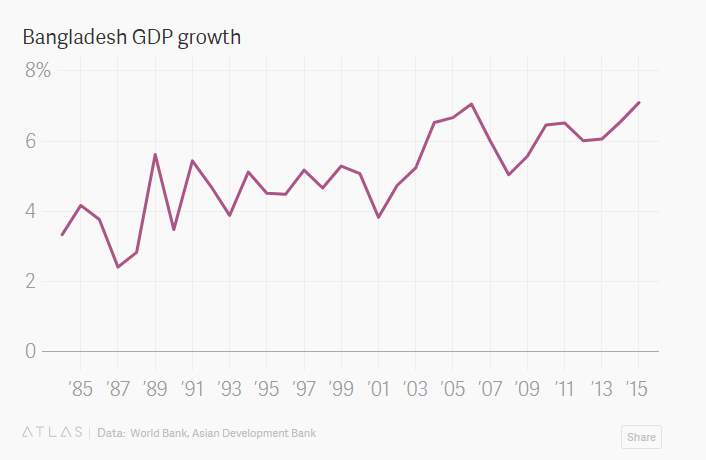
Figure 2: Bangladesh GDP Growth rate source from: https://www.theatlas.com/charts/ry_HA_HAl

Figure 3: Poverty in Bangladesh is on the decline source from: https://www.theatlas.com/charts/Sy0CG1OCx
1.2.3 Labour
According to the Bangladesh bureau of statistics surveys report, the total population in Bangladesh was 158.5 million and there were about 79.6 million are male and 78.9 million are female, and it shows that the Bangladesh is a country with a high number of young population (0-14 years) if compared with the aged 65+ years, which are about 33 percent were in aged 0-14 years but only 4.7 per cent were in aged 65+ years (appendix d). In Bangladesh, the labour force of population are estimated at 58.5 per cent for the population aged 15 or older and about 81.9 percent are male and females about 35.6 percent. The employment rate are estimated at 59.5 million of people (56.1 per cent) aged 15 or older was employed which are 17.8 million are female and the rest are males, and about 2.6 million was unemployment, about 50.8 per cent were paid on monthly salary and 35.1 per cent on daily and only 8.3 per cent were paid weekly. The average salary on monthly basis is about 13,125 Taka ($158 US Dollar) for male and for female is about 12,065 Taka ($145 US Dollar), the wages gap are occurred by gender, sex and also the occupation types. There are three board groupings that are classification of economic activities which are Agriculture, Industry and Service. There are 42.7 per cent of employed population that worked in agriculture and followed by 36.9 per cent that worked in service and about only 20.5 in industry sectors (Bangladesh bureau of statistics with technical support from the World Bank, 2017). There are about 43.2 per cent of the employed population were own their account worker, and 39.1 per cent were employee, 14.5 per cent were contributing family workers and only 2.7 per cent were employers (Bangladesh bureau of statistics with technical support from the World Bank, 2017).
1.2.4 Immigration of Bangladesh
The main host country that Bengali migrants are India, Saudi Arabia, United Arab Emirates, Malaysia, Kuwait and United Kingdom (Etzold, Mallick, 2015). Bangladesh is a small country that has 158 million of population with the 5 to 6 per cent rate of economic growth since the mid-1990s and also has the important development such as education, population control and reduced the hunger (Kibria, 2011)., in contrast, there are the claims that widespread of the poverty in the country, underemployment, and youthful age are the main reason that influence and push the Bangladeshi people to be migration (Kibria, 2011). Etzold, (2015) also mentioned that the environmental in Bangladesh are influenced the people to leaving the country and working oversea such as natural disaster, sea level rise, flood, cyclones, storms and changing rainfall regimes because these things are related and important to people’s livelihoods and security, together the economy and environmental are drives of the mind of Bangladeshi to migrate. Moreover, in 2015 it showed that about 4.28 per cent of Bangladesh population lived outside the country (Iomint, 2015).
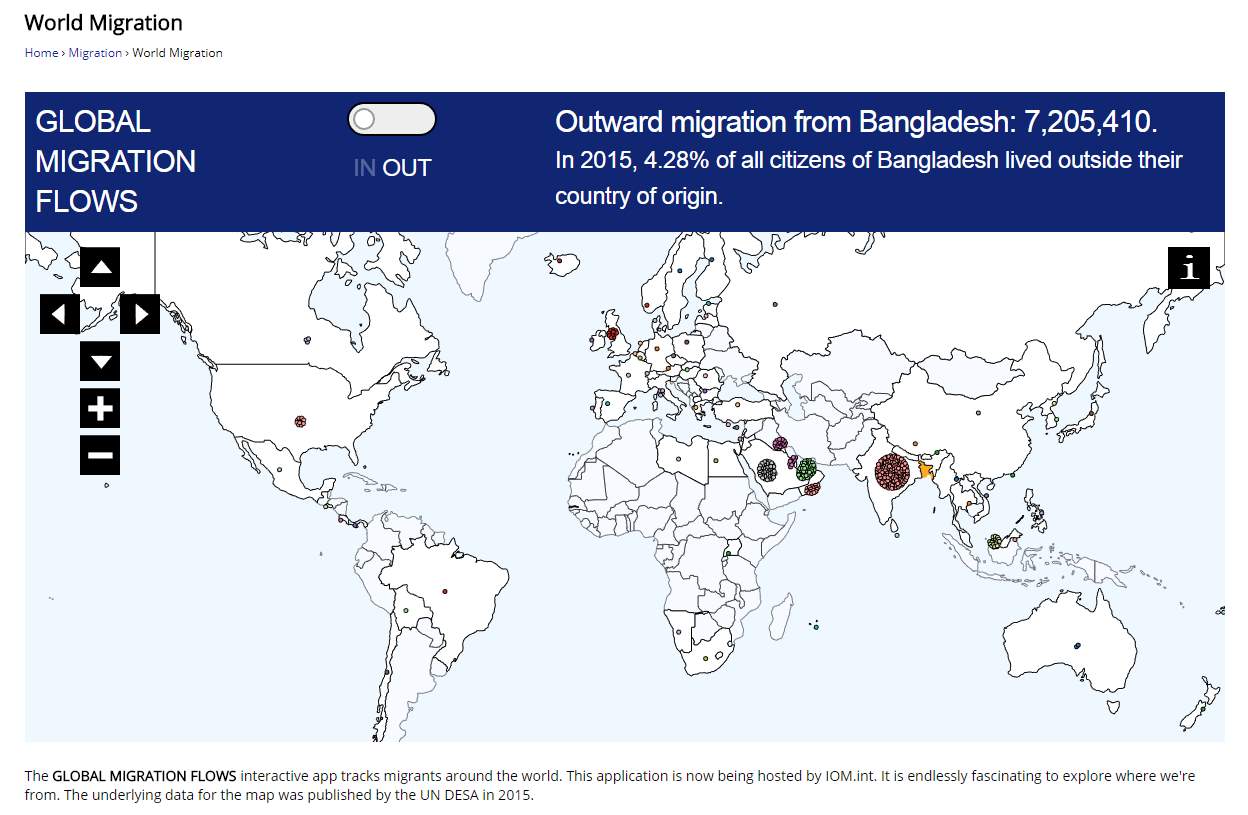
Figure 4: Map of migration flows in the world (Iomint, 2015) Source from: https://www.iom.int/world-migration
Etzold, Mallick, (2015) claims that the Gulf Cooperation Council (GCC) are the main destinations for Bangladeshi labour, since 1980 to 2010 the number of migrants labour from Bangladesh increased from 25,000 to more than 250,000 per year, it is about 1.5 million of Bangladeshi labours from 2005 to 2010 that worked in the GCC. Most of Bangladeshi worker migrated to United Arab Emirates (UAE) (646,729), Saudi Arabia (523,342), and Qatar (153,458), these three countries is the member states of the GCC. Moreover, other important destination countries are India (630,451), and Malaysia (197,715) which is the country in the Asia and following by the USA (128,303), United Kingdom (106,214), Kuwait (99,746), Bahrain (87,794), Italy (61,414) and other countries (330,881), see figure 2.
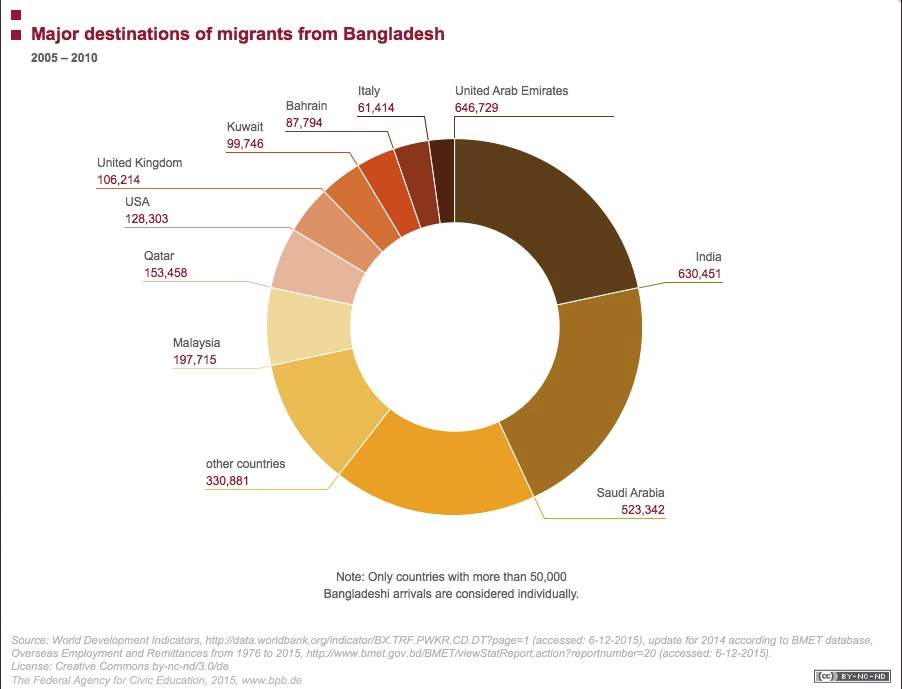
Figure 5: Major destinations of migrants from Bangladesh in 2005-2010 (Etzold, Mallick, 2015) Source from: http://www.bpb.de/gesellschaft/migration/laenderprofile/216104/international-migration-from-bangladesh
In 2013, according to the UN officially data, stated that more than 7.8 million of Bangladesh people were living in 89 countries but there are the main top ten countries that Bangladeshi migration stock, which are India(3,230,025), Saudi Arabia(1,309,004), UAE(1,089,917), Malaysia(352,005), Kuwait(279,169), Great Britain and Northern Ireland(239,608), Qatar(220,403), USA(204,065), Pakistan(186,114) and Oman(148,314) (Etzold, Mallick, 2015). See figure 3.
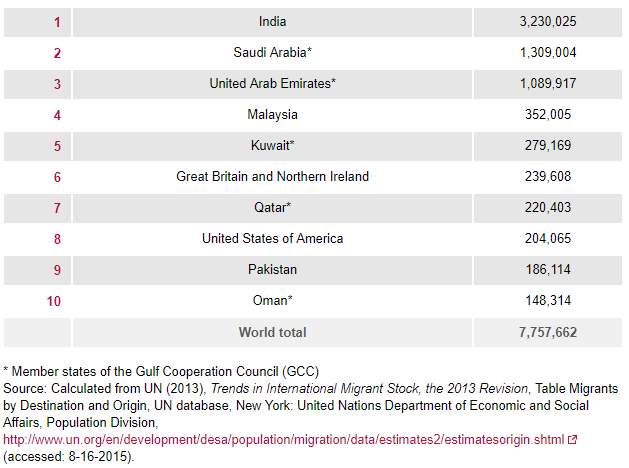
Figure 6: Top ten countries of Bangladeshi migration stocks, 2013 (Etzold, Mallick, 2015) Source from: http://www.bpb.de/gesellschaft/migration/laenderprofile/216104/international-migration-from-bangladesh
1.2.5 Environment
Bangladesh is a low lying deltaic country with the highest population intensity in the limited land in the world, and is the country that most weakened in the world by the effects of the climate change such as a rising sea level, suffering from cyclones, frequent flooding and droughts, and the loss of biodiversity, these situations are linked to the global warming issue (Undporg, 2018). There are natural resources in the Bangladesh which are natural gas, arable land, timber and coal, Bangladesh’s land are around 50 per cent of the country stands above the sea level about 10 meters and it had three types of landscaps which are floodplains over 80 per cent of the land area, hills over 12 per cent and terraces about 8 per cent. There are three major rivers in the country which are Padma, the Meghna and the Brahmaputra and also about 700 others rivers, streams and canals which gives a huge length of water areas (Asian development bank, 2004). Due to the intensity of the population in country, many people are landless and limited access to the drinking water and also the water pollution in the fishing areas because of the contaminated of the commercial pesticides and the naturally contaminated from the arsenic of the ground water (Sadmim, 2016).
In this research, will talk about the immigration of labour: A case of Bangladesh and the literature reviews will be provides the background of the Bangladesh migrants and to support the finding data and statistics that related to the research, and then the discussion of the migrants trend analysis and the migrants people are skilled or unskilled, then the reason that attractive the Bangladesh to migrants will be illustrated including the migrants personal profile and the contribution will be stated at the end. Finally, the conclusion and recommendation will be illustrate in this research to encourage the reader ideas.
2.0 Literature reviews
Today, world are moving and changing fast including economic and technology, migrant people moving across the world from one place to another place to finding the better life and improving their standards of living and also to escaped from the poverty, in global workforce are estimated at 150.3 million that were migrant workers which is about 72.7 per cent of 232 million international migrants of working age population in 2013 (Iloorg, 2015). In this review of literature, will be focused on the conditions of Bangladesh migrant labour, as Bangladesh is becoming the biggest country that exporters of migrant workers which is average around 400,000 leaves the country every year to be employed in overseas (Iloorg, 2017). Due to the huge amount of Bangladesh people that leaving the country, there are reasons that influence the Bangladesh people and the destination countries will be discussed in following.
This literature reviews will be divides into five sections, the first section is trend analysis which will discussed the trends in migration labour from Bangladesh in the last 15-20 years, the second section is the reason that made the Bangladeshi migrating, the third section is will be about the types of occupation or jobs that Bangladeshi are working in and they are working in the field that skilled or un-skilled work. The personal profile of Bangladeshi migrant will be discussed in the fourth section and the last section will indicated about the contribution of the migration of labour in Bangladesh. All of the above section, It will be focused on the migration of labour from Bangladesh to Malaysia.
Under the migration, there are two basics types according to the studied of demographics, which are internal and international migration. Internal migration means to move within the nation such as between cities or states, international migration refers to people that moving out their country to live in another country, it can be classified in two types which are legal immigrants and illegal immigrants, legal immigrants means that people are moved with the legal or law permission of the receiver country, and the illegal immigrants means that people who moved without legal or law permission and also refers to refugees people. As the migration means that people move from one country to another country as for different reasons and it’s has different affect the overall migration process and also has the broad implications for all both countries, and also the differences reasons that cause people migration are build differences outcomes, there are no single theory of migration that can provide best explanation of the migration process (Jrankorg, c2018).
The social science have produced various theories that explain several aspect of migration, it is can be classified into four categories which are classical push-pull theory, economic models, sociological models, and integrated theories (Aniella, 2013). According to Yang, 2010, the push-pull is the earliest classic theory that explained the migration, this theory based on the studied of Ernest Ravenstein, who have analysed the internal migration in England from 1871 to 1881 and Everett Lee, American demographer, who have generated it as a general theory of both internal and international migration. There are the basic ideas for migration which is push factor and pull factors, push factors refers to the situation the push people in the origin to leave their country such as natural disasters, congested population, political disturbances, and environmental disadvantages, the pull factors means that the destination country attract people to move to that country such as environment advantages, economic opportunities, and political support. These push-pull factors are relative and it seem to be like a two sides of the coin which is means that a pull from the destination country is also a push from the origin country (for example, better wages in destination country (pull) means a lower wages in the origin country (push)). This push-pull theory is explained the contribution of the migration flow and also to reflects that push and pull factors are have others conditions such as cross-national connections, social networks, ability to migrate and policy, moreover migrants are not only the poorest people from the poorest place.
Economic model is a theory that based on equilibrium theory, human capital theory, the new home economics of migration, and segmented labour market theory. Equilibrium theory is developed from the economic models to explain internal labour migration in the process of economic, this theory are clarify about the labour demand and supply and also wages that disequilibrium in the rural-urban of migration within the country. Then it has applied to the international migration and it focused on the reason that international migration is caused by the disequilibrium between the supply and demand for labour of the sending and receiving country as well as the wages differences, there are three key limitations, 1.) It does not consider immigration and emigration policies which is important in international migration, 2.) Economic different in wages and employment are necessary term, but is not sufficient, 3.) Opposite to the prediction of the theory (migrant may move from higher wages origin to lower wages country (yang, 2010).
Human capital theory was generated by Sjaasted, this theory states that migration as an investment which will increasing the productivity in human resources, and it has cost but also has returns. This theory explained that people are migrate because expect positive returns and better opportunities are greater in the future and these motivate people to migrants. Later, this theory has elaborated and expanded by Davanzo which is focused on different types of migration, first, the explain of the human migration in both internal and international, second, to capture the factor of migration which means that people move because they want better life, third, it is not only about the economic but it also the value of expected returns in the future. Human capital theory can explain only why people want to move but it does not explain why they can move to another country (yang, 2010).
3.0 Bangladesh migrants to Malaysia
3.1 Trend Analysis of Bangladesh migrant to Malaysia
Every year, a thousands of Bangladeshi migrants to Malaysia to working and sending money to their family. Malaysia is becoming the main the destinations for Bangladeshi worker which is about 500,000 people in 2017 (Corraya, 2017).
During the early 1990s, the decreased of migration flow because of the Persian Gulf War and it affect the countries that states member in the GCC (Sultana, 2008). The trends of movement of the migration of Bangladeshi to Malaysia began in 1992, and in that time Malaysia was shortage of the labour, so the agreement about the transfer of the large scale of labour between Bangladesh and Malaysia were create. And again in 1994 about 50,000 worker transfers to Malaysia by another agreement, Bangladesh signed MOU with Malaysia in 2005 and in 2006 to June 2007 a large scale of worker which are 104,050 migrant labour from Bangladesh go to Malaysia. As the resulted show that from 1992 to 1995, the number of Bangladeshi that worked in Malaysia are about 89,111 worker (Abdul, 2001) Since 1976 to 2009, Malaysia is the most important that officially accepted about 698,736 Bangladeshi (Etzold, Mallick, 2015).
Rahman, Uddin, Albaity, (2014) stated that since 2003-2013, about 0.443, 661 million Bangladeshi migrant labour go to work in Malaysia. In2013, Malaysia has stock the migrant labour from Bangladesh about 352,055 worker which is a large scale of people but Indonesia has highest number of migrant labour in Malaysia which are 1,051,227, following by Bangladesh, Myanmar (347,768), Nepal (201,345) and India (130,320) (Unicef, 2017) because in 2013, Malaysia and Bangladesh has agreement that Malaysia will recruit up to 500,000 worker to work in manufacturing, service, agriculture and construction in the next five years (Agence France, 2013). But in 2016, the number of the migrant labour in Malaysia was fall down to 749,226 from Indonesia, Nepal (411,364), Bangladesh (237,991) and India (121,430) because of the employment period were expired and the migrant labour have to go back to their origin (Dailystar, 2016).
In June 2015, Bangladesh and Malaysia signed a memorandum of understanding in Dhaka, which is known as government to government, this agreement is about the Malaysia will recruit 1.5 million of Bangladeshi for jobs over the next three year through private sector under new agreement which is resulted in the increased of Bangladeshi migration flowing to Malaysia estimated about 3,000 workers every month since this agreement started in June 2015, which showed that the trend of migration from Bangladesh to Malaysia will continued to increasing significantly (Siddiqui, 2016).
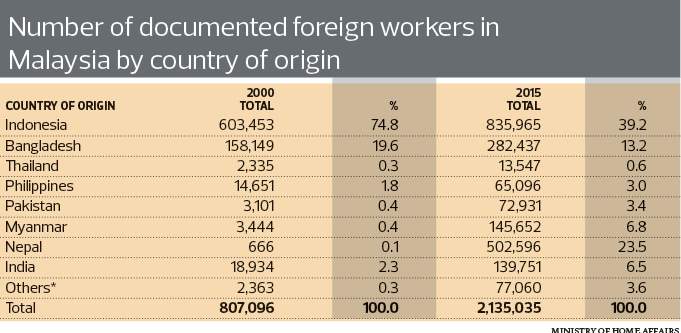
Figure 7Number of documented foreign workers in Malaysia by country of origin Source from: http://www.theedgemarkets.com/article/malaysias-foreign-worker-conundrum (Theedgemarkets, 2017)
3.2 The reason that made Bangladeshi migrating
In Bangladesh, the migration has been important strategy for the Bangladeshi as it showed that every years thousands of the people migration to working overseas from Bangladesh, the migration began within the country first which migrated from rural to urban areas to avoid the natural disaster, as the time gone the large number of people living in the urban areas and it became too tightly (Hoque, 2017), so a lot of Bangladeshi are migrants to working in overseas.
The reason that made or influence or motivations Bangladeshi to migrants are the socioeconomic and the natural hazards in the Bangladesh, even the Bangladesh economic has a stable with 5-6 per cent growth since 1996-2208 but it is still not enough to occupied all the worker in the country and the poverty are the important things as well as the underemployment rate that made Bangladeshi to migrants. The natural hazards also motivated the Bangladeshi to migrants because of its country geographic that about 80 per cent of areas are situated in the flood and the sea level are risen, this natural disaster made the Bangladeshi has not had enough food and fell not secured in their life, so they migrant to overseas to seeking for the better standard of living for themselves and family (Ranjan, 2015).
The political in Bangladesh are the big support that also influence the Bangladeshi to migrants such as The Safe Migration for Bangladeshi Workers (SMBW), International Organization for Migration (IOM) and International labour Organization (ILO). The SMBW projects has begun in 2013 which is to help the worker to access the training, reliable information and service that will help to improve the Bangladeshi migrations, which is implemented by BRAC, financed by the Japan Social Development Fund (JSDF) and managed by the World Bank (The world bank, 2017). Moreover, the IOM in Bangladesh is the organization that study, research, finding to identified policy, strategy and operational plan that to help the migration management in Bangladesh which is provide an important information for migration (Iom, 2015). The ILO that funds by Swiss Agency for Development and Cooperation (SDC) has announced the plan from 2016 and ends in 2018, this project will work with the Ministry of Expatriates’ Welfare and Overseas Employment which will help the Bangladeshi worker to migrants with the decent work, quality labour market information, occupation classification, pre-departure training and welfare service aboard as well as provides the research and technical advisory support for stronger labour negotiations for decent work and also facilitate the engagement of stakeholders (Ilo, 2016).
3.3 Types of the occupation/jobs
The Bangladeshi migrant labour can be classified in to four groups which are professional, skilled, semi-skilled and less skilled, as the number of 7.8 million of the Bangladeshi migrant labour all over the world, there are only 2.2 percent that are professional, skilled are occupied about 31.5 per cent, semi-skilled labour are about 14 per cent, and 52.3 per cent for labour that has less skilled (Giz and Ilo, 2015).
The types of migration labour from Bangladesh to Malaysia are categories in 2 types which are skilled and less or un-skilled workers, the majority of migrant labour from Bangladesh are low skilled because of the
In the past Bangladesh migrant worker are working in the agriculture plantations sector only due to the restriction from Malaysia since early 1990s to 2015, in 2015 Malaysia are allowed the Bangladeshi migrant labour to working in the Malaysia’s services, manufacturing and construction sectors and also announced the agreement that Malaysia will recruit about 1.5 million from Bangladesh (Eiu digital solutions, 2016).
3.4 Profile of people that migrant
3.5 Contribution of the migration labour from Bangladesh to Malaysia
4.0 Policies
Bangladesh
Malaysia
5.0 Methodology
This research is mainly relies on the accurate secondary data, source, and statistics that are available on the internet including the report that officially made by the government, published report or articles and the news such as International Labour Organization, World Bank report and etc. The studying of those secondary data will be analysis by author, and it will help to support the author’s research topic which is about migration labour; A case of Bangladesh. The data and statistics of the Bangladesh migrant workers will be show in this research.
6.0 Conclusion
7.0 Recommendation
8.0 Reference List
Anderson, Bridget. (2017). Migration Observatory. Retrieved 25 November, 2017, from http://www.migrationobservatory.ox.ac.uk/resources/briefings/who-counts-as-a-migrant-definitions-and-their-consequences/
Etzold Benjamin, Mallick Bishawjit. (2015). Wwwbpbde. Retrieved 27 November, 2017, from http://www.bpb.de/gesellschaft/migration/laenderprofile/216104/international-migration-from-bangladesh
Ciagov. (2017). Ciagov. Retrieved 27 November, 2017, from https://www.cia.gov/library/publications/the-world-factbook/geos/bg.html3
Diffencom. (2017). Diffencom. Retrieved 26 November, 2017, from https://www.diffen.com/difference/Emigrate_vs_Immigrate
Parry, Sarah. (2017). Encyclopedia Britannica. Retrieved 26 November, 2017, from https://www.britannica.com/topic/immigration
Sakhawat, A. (2016). Dhaka Tribune. Retrieved 27 November, 2017, from http://www.dhakatribune.com/bangladesh/2016/12/18/bd-migration-36/
Szczepanski, K. (2017). ThoughtCo. Retrieved 26 November, 2017, from https://www.thoughtco.com/bangladesh-facts-and-history-195175
Unesco. (2017). Migrant/Migration. Retrieved 25 November, 2017, from http://www.unesco.org/new/en/social-and-human-sciences/themes/international-migration/glossary/migrant/
Vore, Adrian. (2017). Sandiegouniontribunecom. Retrieved 25 November, 2017, from http://www.sandiegouniontribune.com/opinion/readers-rep/sdut-immigrant-migranr-undocumented-europe-syria-2015sep25-story.html
Bangladesh bureau of statistics with technical support from the World Bank. (2017). Quarterly Labour Force Survey (QLFS) 2015-16. Retrieved 11 December, 2017, from http://bbs.portal.gov.bd/sites/default/files/files/bbs.portal.gov.bd/page/96220c5a_5763_4628_9494_950862accd8c/QLFS_2015.pdf
Iloorg. (2017). Labour migration in Bangladesh. Retrieved 11 December, 2017, from http://www.ilo.org/dhaka/Areasofwork/labour-migration/lang–en/index.htm
Iloorg. (2015). International Migrants Day. Retrieved 11 December, 2017, from http://www.ilo.org/global/topics/labour-migration/news-statements/WCMS_436140/lang–en/index.htm
Kibria, N. (2011). Migrationpolicyorg. Retrieved 11 December, 2017, from https://www.migrationpolicy.org/article/working-hard-money-bangladesh-faces-challenges-large-scale-labor-migration
Etzold, B. (2015). Transreorg. Retrieved 11 December, 2017, from http://www.transre.org/en/blog/environmental-change-migration-and-adaptation-bangladesh/
Iomint. (2015). International Organization for Migration. Retrieved 15 December, 2017, from https://www.iom.int/world-migration
Abdul, Rashid, Abdul, Aziz. (2001). Unescapsddorg. Retrieved 15 December, 2017, from http://www.unescapsdd.org/files/documents/PUB_APPJ-Vol-16-No-1.pdf
Corraya, Sumon. (2017). Thousands of Bangladeshi migrant workers in Malaysia send remittances home. Retrieved 21 December, 2017, from http://www.unescapsdd.org/
Sultana, Nayeem. (2008). The Bangladeshi Diaspora in Malaysia. Retrieved 15 December, 2017, from https://books.google.co.nz/books?id=65aSWwEiDu4C&pg=PA32&lpg=PA32&dq=Bangladeshi+migrant+to+Malaysia+in+past+20+years+ilo&source=bl&ots=f9vi69i8Wm&sig=N1KP8hQEefORyXt-xOigGd3Pqqs&hl=en&sa=X&ved=0ahUKEwjroJG5pJrYAhWBa7wKHchLD6Y4ChDoAQhSMAg#v=onepage&q&f=false
Unicef. (2017). MIGRATION PROFILES. Retrieved 16 December, 2017, from https://esa.un.org/miggmgprofiles/indicators/files/Malaysia.pdf
Chowdhury, Kamran Reza. (2016). BenarNews. Retrieved 16 December, 2017, from http://www.benarnews.org/english/news/bengali/malaysia-workers-02182016163336.html
Siddiqui, Tasneem. (2016). International labour migration. Retrieved 16 December, 2017, from http://www.thedailystar.net/supplements/25th-anniversary-special-part-5/international-labour-migration-212671
Dailystar. (2016). In Malaysia: Bangladeshis are 3rd largest legal migrants. Retrieved 16 December, 2017, from http://www.thedailystar.net/backpage/malaysia-bangladeshis-are-3rd-largest-legal-migrants-1312927
Eiu digital solutions. (2016). Bangladesh-Malaysia migration deal in preparation. Retrieved 16 December, 2017, from http://country.eiu.com/article.aspx?articleid=1533932537
Giz and Ilo. (2015). Labour market trends analysis and labour migration from South Asia to Gulf Cooperation Council countries, India and Malaysia. Retrieved 16 December, 2017, from http://www.oit.org/wcmsp5/groups/public/—asia/—ro-bangkok/—ilo-kathmandu/documents/publication/wcms_377416.pdf
Rahman, Mahfuzur, Uddin, Md. Shanh Jalal, Albaity, Mohamed. (2014). Socio-economic Conditions of Bangladeshi Migrant Workers in Malaysia. Retrieved 16 December, 2017, from http://repository.um.edu.my/36636/1/J.%20Basic.%20Appl.%20Sci.%20Res.,%204(3)246-252,%202014.pdf.
Agence, France. (2013). Malaysia resumes hiring Bangladeshi migrants. Retrieved 16 December, 2017, from http://newsinfo.inquirer.net/333497/malaysia-resumes-hiring-bangladeshi-migrants
Theedgemarkets. (2017). Malaysia’s foreign worker conundrum. Retrieved 21 December, 2017, from http://www.theedgemarkets.com/article/malaysias-foreign-worker-conundrum
Hoque, Jamil. (2017). Academiaedu. Retrieved 19 December, 2017, from http://www.academia.edu/10725163/Assignment_on_causes_of_Migration_in_perspective_of_Bangladesh
Ranjan, Amit. (2015). Migration from Bangladesh: Causes and Challenges. Retrieved 19 December 2017, from https://notesonliberty.com/2015/09/07/migration-from-bangladesh-causes-and-challenges/
The World Bank. (2017). In Bangladesh, Migrant Workers Can Dream of a Better Life with Access to Better Resources. Retrieved 19 December, 2017, from http://www.worldbank.org/en/news/feature/2017/07/30/in-bangladesh-migrant-workers-can-dream-of-a-better-life-with-access-to-better-resources
Iom. (2015). IOM in Bangladesh. Retrieved 19 December, 2017, from https://www.iom.int/countries/bangladesh
Ilo. (2016). Bangladesh, ILO and Switzerland launch new initiative to support decent work for migrant workers. Retrieved 19 December, 2017, from http://www.ilo.org/dhaka/Informationresources/Publicinformation/Pressreleases/WCMS_477058/lang–en/index.htm
Husain, Syed Sajjd, Tinker, Hugh Russell. (2017). Bangladesh. Retrieved 29 December, 2017, from https://www.britannica.com/place/Bangladesh
Indexmundi. (2017). Bangladesh Geography Profile 2017. Retrieved 29 December, 2017, from https://www.indexmundi.com/bangladesh/geography_profile.html
Sadmim, hossain. (2016). what are some geographical features of Bangladesh? Retrieved 29 December, 2017, from https://www.quora.com/What-are-some-geographical-features-of-Bangladesh
Abdur rahim harmachi, Sumon, mahbub. (2015). Bangladesh economy moves up 14 places on World Bank, IMF scale in two years. Retrieved 29 December, 2017, from https://bdnews24.com/economy/2015/06/09/bangladesh-economy-moves-up-14-places-on-world-bank-imf-scale-in-two-years
Dan, Kopf. (2017). Atlas Bangladesh GDP growth. Retrieved 29 December, 2017, from http://www.theatlas.com/charts/ry_HA_HAl
The World Bank. (2016). BANGLADESH DEVELOPMENT UPDATE Sustained Development Progress. Retrieved 29 December, 2017, from http://documents.worldbank.org/curated/en/579721475673660627/pdf/108745-WP-SAREC-PUBLIC-FinalBangladeshDevelopmentUpdateOctober.pdf
Dan, Kopf. (2017). One of the world’s happiest economic stories comes from South Asia, but not India. Retrieved 29 December, 2017, from https://qz.com/964114/the-happiest-economic-story-in-the-world-right-now/
Undporg. (2018). UNDP in Bangladesh. Retrieved 30 December, 2017, from http://www.bd.undp.org/content/bangladesh/en/home/ourwork/environmentandenergy/overview.html
Asian development bank. (2004). Country Environmental Analysis Bangladesh. Retrieved 30 December, 2017, from https://www.adb.org/sites/default/files/institutional-document/32179/ban-cea-jul2004.pdf
Jrankorg. (c2018). Migration – Theories of Migration. Retrieved 2 January, 2018, from http://family.jrank.org/pages/1170/Migration-Theories-Migration.html
Jrankorg. (c2018). Migration – Types Of Migration. Retrieved 2 January, 2018, from http://family.jrank.org/pages/1169/Migration-Types-Migration.html
Aniella, M. V. I. E. R. I. U. (2013). THE PROCESS OF MIGRATION AND INTEGRATION: A THEORETICAL INQUIRY. Social Research Reports, 24, 7-15. Retrieved from https://search.proquest.com/docview/1665202535?accountid=41154
Yang, P. Q. (2010). A THEORY OF ASIAN IMMIGRATION TO THE UNITED STATES. Journal of Asian American Studies, 13(1), 1-34,124. Retrieved from https://search.proquest.com/docview/193925210?accountid=41154
9.0 Appendices
Appendix A: Source from: https://data.worldbank.org/indicator/NY.GDP.MKTP.CD?end=2016&locations=BD&name_desc=true&start=1960&view=chart
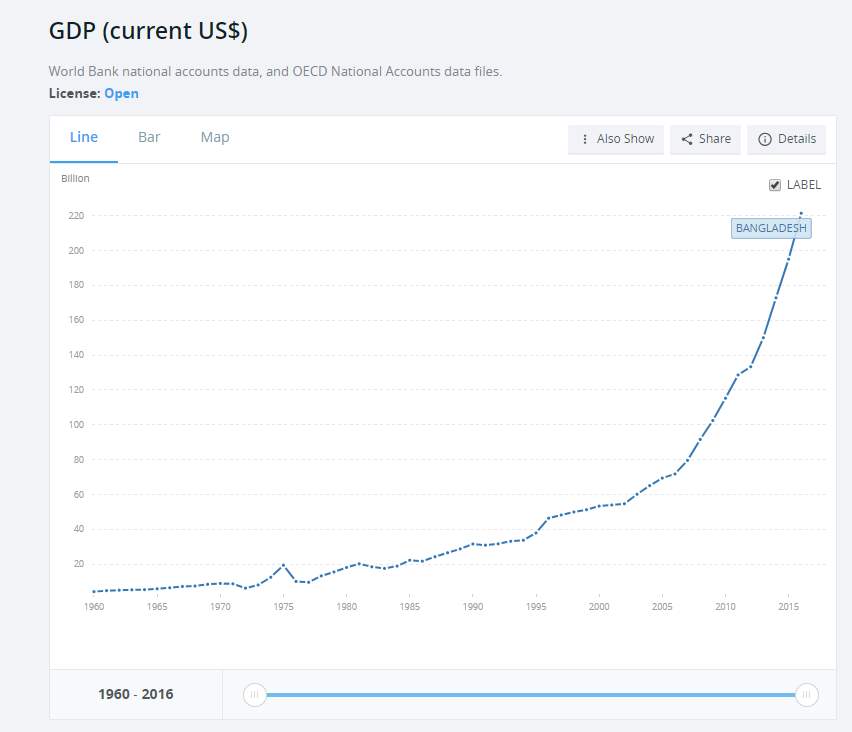
Appendix B: Source from: https://www.theatlas.com/charts/By6WF-dAx
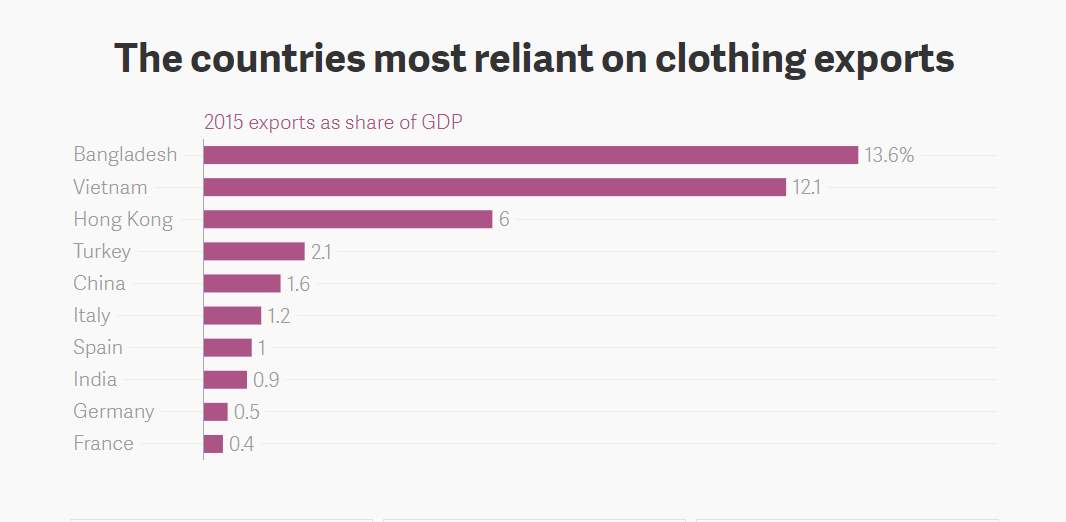
Appendix C: Source from: https://data.worldbank.org/indicator/NY.GDP.PCAP.CD?end=2016&locations=BD&start=1996&view=chart
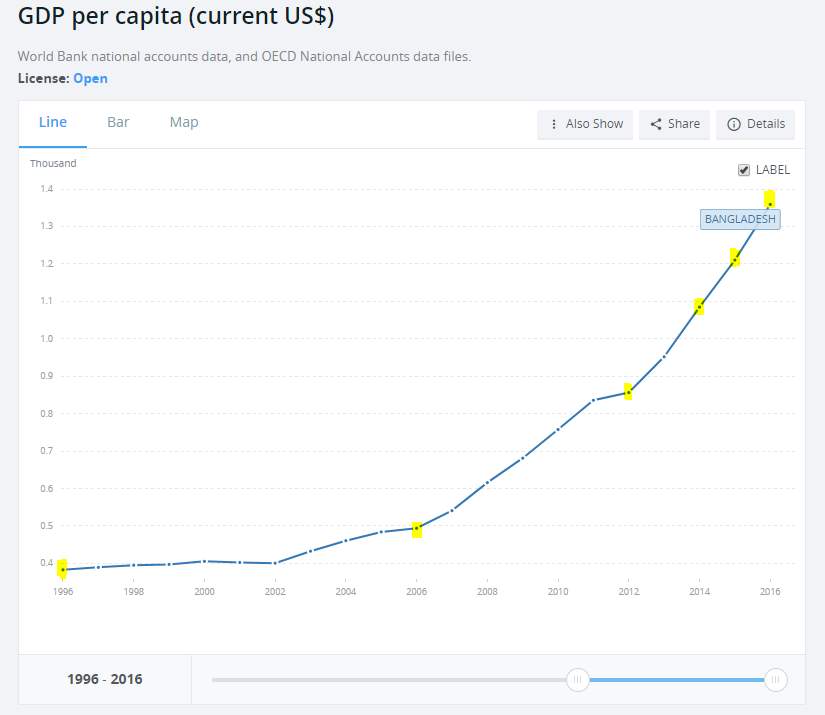
Appendix D: Source from: http://bbs.portal.gov.bd/sites/default/files/files/bbs.portal.gov.bd/page/96220c5a_5763_4628_9494_950862accd8c/QLFS_2015.pdf
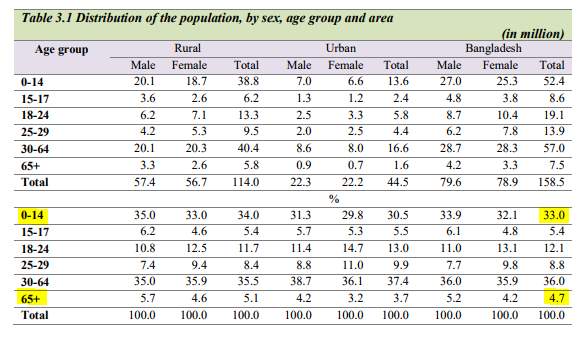
Appendix E: Source from: http://bbs.portal.gov.bd/sites/default/files/files/bbs.portal.gov.bd/page/96220c5a_5763_4628_9494_950862accd8c/QLFS_2015.pdf
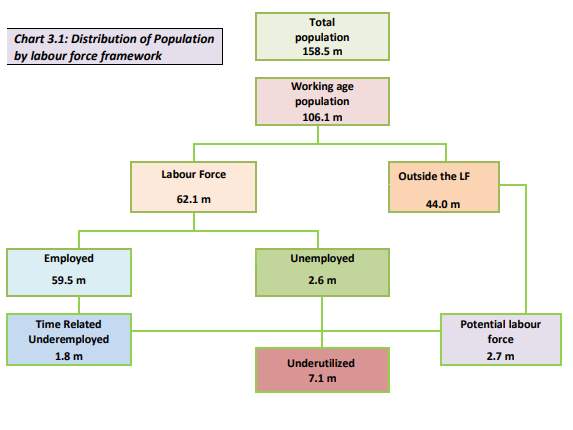
.
Timeline
30th Dec submit most of the work as a draft of
10th Jan Submit second draft of report + PPT
11th Jan final report
Cite This Work
To export a reference to this article please select a referencing stye below:
Related Services
View allRelated Content
All TagsContent relating to: "Immigration"
Immigration is the act of someone travelling or moving to a country they are not a citizen of to live on a permanent basis. Someone that has gone through the process of immigration is defined as an immigrant.
Related Articles
DMCA / Removal Request
If you are the original writer of this dissertation and no longer wish to have your work published on the UKDiss.com website then please:




